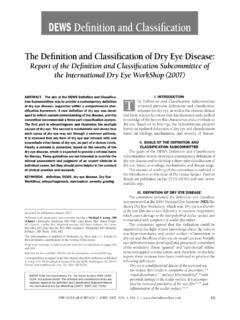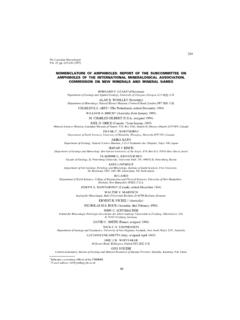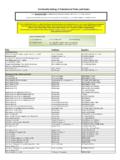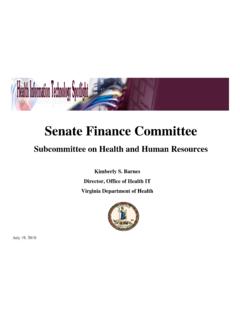Transcription of Ceftriaxone – safety in neonates
1 Second Meeting of the subcommittee of the Expert Committee on the Selection and Use of Essential Medicines Geneva, 29 September to 3 October 2008 Ceftriaxone safety in neonates Ceftriaxone has a broad spectrum of in vitro activity and is used in neonates for treating gonococcal ophthalmia and as a second line drug for sepsis and meningitis. It can precipitate if used together with calcium leading to severe reactions including neonatal death. Other possible adverse events of significance in the neonate include biliary sludging, kernicterus and increased chances of invasive candidiasis.
2 Third generation cephalosporin use can also lead to an increase in infections due to Extended spectrum beta lactamase (ESBL) producing organisms. A recent FDA alert advocates that Ceftriaxone should not be mixed with calcium-containing products and not administered in the same or different infusion lines or sites in any patient within 48 hours of each other. This can be problematic in neonates especially in those requiring total parenteral nutrition. A letter (Nov, 2006) to health professionals from AFSSAPS, France states that Ceftriaxone is contra indicated in premature infants till 41 weeks of age (GA at delivery + wks after birth) and in term neonates less than 28 days if there is hyper bilirubinemia or if receiving calcium.
3 BNF C recommends caution in preterm neonates and states it is contra indicated in neonates with jaundice, hypoalbuminemia, acidosis or impaired bilirubin binding. It is administered either IM or IV. Maximum single dose for neonates is 150mg. The strengths commercially available are 250 mg, 500mg and 1gm as powder for injection. Recommendation Age restriction required since fatal adverse events are reported Not for use in premature infants till 41 wks total age Consider restriction below 1 m since there are several situations where it is contraindicated in this age group and other alternatives available Review Ceftriaxone is used mostly in hospital practice for neonatal sepsis, meningitis and ophthalmia neonatorum.
4 Its broad spectrum of activity, once daily dosing and good penetration into CSF are features favouring its use. However, there are not many reports on its efficacy or safety in neonates . Efficacy There is paucity of data to clearly understand the agents of early and late onset sepsis in community settings in developing countries. Hospital based studies show that Gram negative bacilli to be most important pathogens. Limited available data show that Gram negative bacilli (Klebsiella and E coli) and S aureus [1] are predominant causes of early onset sepsis in home born neonates and non nosocomial infections in developing countries.
5 Frequency of infections with Streptococcus pneumoniae and S pyogenes increase from first week of life. There is significant regional differences in the proportions of cases due to different bacteria [1]. There are important regional differences in the resistance patterns of bacteria causing these infections as well. Here again there is a serious lack of data from community settings. AMR amongst Gram negative bacilli to first line drugs is alarmingly high in some regions, notably south Asia [1]. Ceftriaxone is active against most bacteria causing neonatal sepsis and meningitis including some resistant to first line therapy.
6 However, ESBL mediated resistance to third generation cephalosporins has appeared among neonatal pathogens. In one report from India 22% of Gram negative bacilli isolated from blood cultures of neonates with septicaemia were ESBL producers[2]. In another report also from India, > 80% isolates from neonatal septicaemia were resistant to Ceftriaxone and were probably ESBL producers[3]. Clinical trials where Ceftriaxone has been evaluated in the new born are scanty. Immediate and long term clinical out come was good in a retrospective analysis of 72 term neonates with Gram negative bacterial meningitis treated with a third generation cephalosporin and amikacin [4].
7 In a study comparing cefotaxime and Ceftriaxone for severe bacterial infections in children, 22 neonates were enrolled. Both were effective and adverse reactions were rare[5]. Other early studies also have shown it to be effective [6]for treating septicaemia and meningitis [7] and safe . Studies have shown single dose therapy to be effective in neonates with gonococcal ophthalmia [8-10] including those due to Penicillinase producing N gonorrhoea. It is therefore currently recommended as first line therapy for gonococcal ophthalmia neonatorum and other gonococcal infections in the new born[11].
8 It is also recommended for prophylaxis in neonates of mothers with untreated gonorrhoea [11]. safety Rocephin label states that safety and efficacy have been established in neonates for the recommended dosages [12] and has been in use for over 20 yrs. In an early study, adverse events like diarrhea (n= 11), vomiting (n=2) and exanthema (n= 1) occurred in 14( )/ 161 neonates . Abnormalities in laboratory test values were observed in 25 ( )/ 152 ( eosinophilia in 14, elevated GOT in 4 and thrombocytosis in 3)[7]. However, recent evidence suggests that use of this drug can cause serious adverse events including fatalities in neonates .
9 Interaction with calcium: Ceftriaxone can interact with calcium and cause precipitation of calcium- Ceftriaxone [12-14]. This can be fatal in preterm and term neonates . Pharmacovigilance in France, recorded severe reactions (4 in 1996 and 1 in 2002) and four neonatal deaths following Ceftriaxone use. Precipitates were observed in the IV line, pulmonary tissue or renal tissue [15]. FDA subsequently identified four more serious reactions, with 3 deaths [15]. Another recent report also documents serious reactions in a premature new born [16].
10 This has led FDA, AFSSAPS and Roche to issue alerts regarding Ceftriaxone and calcium use [13, 14]. FDA alert states that generally, fatalities have been associated with simultaneous administration of Ceftriaxone and calcium-containing products. However, administration of the two products at different times and via different infusion lines has also been fatal. Therefore, Ceftriaxone should not be mixed with calcium-containing products and not administered in the same or different infusion lines or sites in any patient within 48 hours of each other (5 Ceftriaxone half lives).














